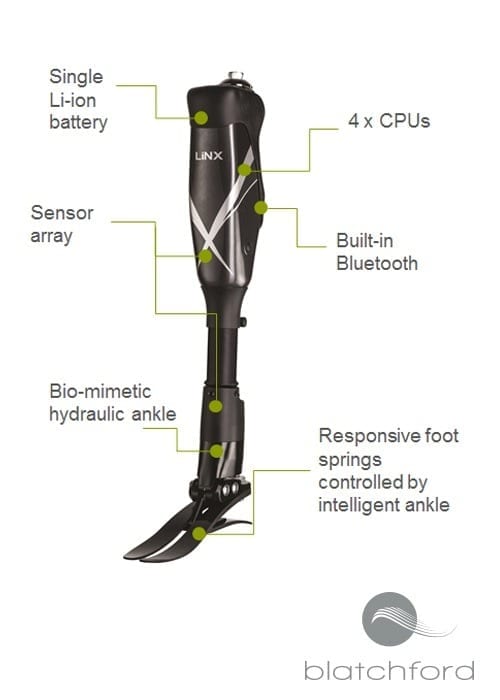The Blatchford Linx is the only true integrated bionic leg on the market, which means it has a microprocessor knee and ankle that share a single control system.
What’s On This Page?
- A Quick Look at the Blatchford Linx
- Sensor & Microprocessor Capabilities
- Benefits & Drawbacks of the Linx’s Design
- Batteries
- Water & Dust Resistance
- Device Weight & User Weight Limit
- K-Level Rating
- User Software
- Warranty
- Price
- Customer Reviews
- User Feedback Survey & Results
- Considerations Before Buying a Blatchford Linx
- Related Information
A Quick Look at the Blatchford Linx
The following video quickly explains the concept and main benefits of the Linx:
This next video shows the Linx taking on more challenging activities:
Blatchford Linx Key Features
Sensor & Microprocessor Capabilities
To understand how bionic knees and ankles work in general, please see A Complete Guide to Bionic Legs & Feet.
The short story is that the microprocessors in bionic knees have three main tasks:
- automatically adjusting the resistance in the knee to ensure the proper level of support through each stage of the Stance Phase regardless of terrain;
- ensuring the optimal release point for the knee to begin the Swing Phase and also the proper foot clearance during this phase, especially when ascending stairs, ramps, etc.;
- assisting in stumble recovery.
Bionic ankles, which are mostly used by below-the-knee amputees, have similar tasks — they’re just focused on the ankle/foot:
- automatically adjusting the resistance in the ankle to ensure the proper level of support through each stage of the Stance Phase regardless of terrain;
- keeping the foot “toes” up during the Swing Phase to create more clearance and reduce the risk of tripping;
- some bionic ankles also actively manage the ankle rotation (i.e. foot angle) based on terrain, and some provide added propulsive power.
The Linx uses seven sensors spread throughout the device to maintain full situational awareness of changes in the terrain, the activity the user is performing, and the movement of the Linx through three-dimensional space.

Based on this awareness, microprocessors adjust the hydraulic resistance in both the ankle and knee, as well as the pneumatic pressure in the knee, to accomplish all of the previously described tasks except providing added propulsive power.
Specifically, in the typical chronology of the human gait, the microprocessors manage:
- the level of hydraulic resistance in the foot as it rolls from the heel strike to the toe push-off during the Stance Phase;
- the release point of the knee as the user transitions from the Stance Phase to the Swing Phase, i.e. the point at which hydraulic resistance in the knee is relaxed to allow the knee to swing more freely;
- pneumatic pressure in the knee to prevent the heel from rising too high in the Swing Phase;
- hydraulic pressure in the ankle to adjust the angle of the foot (i.e. ankle rotation) to ensure “toes” up during the Swing Phase; this, again, is to reduce the risk of catching the front of the foot on an obstacle and causing a trip;
- pneumatic extension of the knee to ensure proper placement of the foot to begin the next Stance Phase.
…and it does all of this in real-time, adjusting to any changes in terrain with each step.
In addition to these core technologies, the Linx also provides specific support for:
- standing;
- sitting;
- cycling.
Benefits and Drawbacks of the Linx’s Design
The most obvious benefit of the Linx’s design is the fluidity of movement that users enjoy while using it. It is not easy for above-the-knee amputees to achieve this fluidity. The simple fact is, the less that remains of a leg above the knee, the more difficult it is for a user to control a prosthetic leg. This is merely a function of the limited muscle power and leverage in the residual limb.
The more that bionic knees and ankles support the residual limb, the easier it is to achieve the kind of smooth gait shown in this short video:
This isn’t just a matter of aesthetics. Transferring some of the load/responsibilities onto a bionic knee and ankle also:
- improves balance and safety, especially by reducing falls;
- expands freedom of mobility;
- reduces the user’s energy expenditure (and not by a small amount; above-the-knee amputees typically expend 60% to 80% more energy walking with non-bionic prosthetics versus natural legs);
- reduces the wear and tear on the user’s other joints and back.
This means that devices such as the Linx not only substantially improve the user’s health and quality of life; they also significantly reduce long-term healthcare costs.
So what are the drawbacks? There is only one: the Linx, like many of its bionic limb counterparts, is still too expensive.
Batteries
The Linx’s battery can last for up to three days depending on the level of activity.
If completely drained, the battery requires up to eight hours to fully charge.
Blatchford recommends that users charge the battery each night.
Water & Dust Resistance
The Linx does not have an official IP rating. However, its user guide contains the following warning about water: “The device is not intended for use when immersed in water or as a shower prosthesis. If the limb comes into contact with water wipe dry immediately.”
Blatchford’s promotional videos show the Linx being used in outdoor environments on sandy terrain. However, there is no mention of dirt or dust resistance in any of its official documentation. In our experience, this means that dust resistance is insufficient to consider it a feature. However, without an IP rating, it is impossible for us to say for certain, so it is probably best to verify with your prosthetist.
Device Weight & User Weight Limit
The Linx weighs 2.6 kilograms. The maximum allowable user weight is 125 kilograms.
K-Level Rating
The Linx is recommended for K3 use.
For a thorough understanding of K-levels, please see the Amputee Coalition’s web page on this topic.
User Software
The Linx does not offer software for the end-users. It does, however, offer configuration software for prosthetists (the Linx Programming App).
User-controlled settings, such as switching to the cycling mode, are activated by pushing a button on the device.
Warranty
Blatchford offers a three-year warranty on the Linx including any repair costs due to defects. Scheduled service is not required during the base warranty period.
Users can also pay to extend the warranty by an additional 12, 24, or 36 months. For the warranty to remain valid under this option, the Linx must be serviced between 30 and 36 months after purchase.
For repairs or service inspections, Blatchford provides a loaner unit upon request. The loaner is free for the first 45 days. Rental fees apply after 45 days.
Price
According to our information, the Linx typically sells for between $60,000 and $70,000 US including the socket and all prosthetist fees.
Customer Reviews
While this isn’t exactly a customer review, it is an in-depth interview with one of the original and longest users of the Linx, Tom Allred.
What makes this interview particularly informative for prospective Linx users is that Tom describes the incremental improvements he experienced as he went from a mechanical hydraulic knee and energy-storing-and-return (ESAR) foot to:
- The Orion Knee (essentially the knee component of the Linx).
- The Elan Foot/Ankle (essentially the foot/ankle component of the Linx).
- The first version of the Linx.
- The second (and latest) version Linx.
Even as the interviewer, we found Tom’s observations of this technology progression to be extremely insightful.
User Feedback Survey & Results
Are you or have you previously been a Linx customer? If so, please share your insights with others looking at the Linx as a possible prosthesis.
Survey
Results
We do not yet have a sufficient number of survey participants to publish fair and accurate results for the Linx.
As soon as we do, we’ll update this section.
Considerations Before Buying a Blatchford Linx
If you are an above-the-knee amputee, we believe that the only issues to consider with the Linx are:
- Do you meet the minimum physical requirements (i.e. K-3 user, etc.)?
- Are you looking for a waterproof prosthesis? If the answer is “yes”, then the Linx won’t do. Instead, look at Ottobock’s C-Leg, Genium, or Genium X3 knees.
- Can you afford it (or have sufficient insurance coverage to pay for it)?
Other than these considerations, we think that the Linx is an ideal solution for above-the-knee amputees. In fact, we suspect that, as costs decline, many manufacturers will eventually create fully integrated bionic legs of their own.
Related Information
For a list of competitive devices, see Current Options for Microprocessor Knees.
To understand more about lower-limb control systems, please see Bionic Leg & Foot Control Systems.
For a comprehensive description of all current lower-limb technologies, devices, and research, see our complete guide.
Click here for more information on Blatchford.
